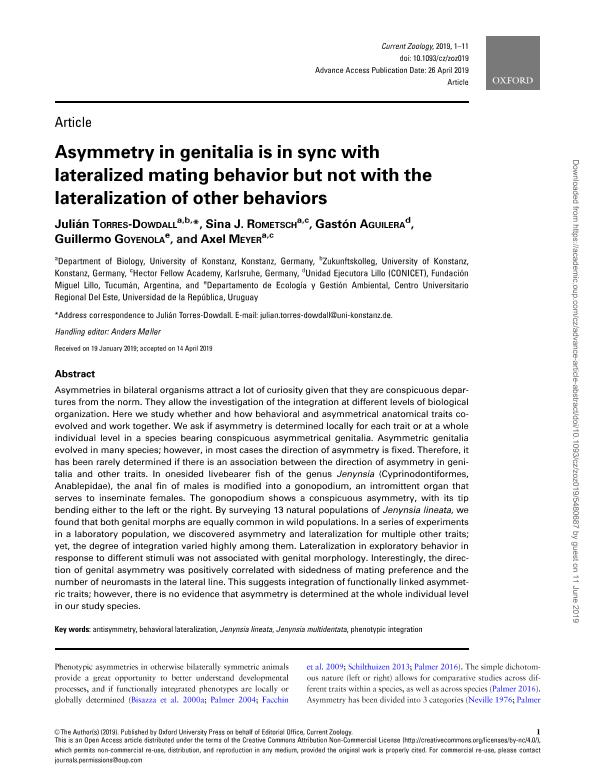Mostrar el registro sencillo del ítem
dc.contributor.author
Torres Dowdall, Julián Roberto

dc.contributor.author
Rometsch, Sina J.
dc.contributor.author
Aguilera, Gaston

dc.contributor.author
Goyenola, Guillermo
dc.contributor.author
Meyer, Axel
dc.date.available
2021-10-05T13:25:08Z
dc.date.issued
2019-04
dc.identifier.citation
Torres Dowdall, Julián Roberto; Rometsch, Sina J.; Aguilera, Gaston; Goyenola, Guillermo; Meyer, Axel; Asymmetry in genitalia is in sync with lateralized mating behavior but not with the lateralization of other behaviors; Oxford University Press; Current Zoology; 4-2019
dc.identifier.issn
2396-9814
dc.identifier.uri
http://hdl.handle.net/11336/142652
dc.description.abstract
Asymmetries in bilateral organisms attract a lot of curiosity given that they are conspicuous departures from the norm. They allow the investigation of the integration at different levels of biological organization. Here we study whether and how behavioral and asymmetrical anatomical traits co-evolved and work together. We ask if asymmetry is determined locally for each trait or at a whole individual level in a species bearing conspicuous asymmetrical genitalia. Asymmetric genitalia evolved in many species; however, in most cases the direction of asymmetry is fixed. Therefore, it has been rarely determined if there is an association between the direction of asymmetry in genitalia and other traits. In onesided livebearer fish of the genus Jenynsia (Cyprinodontiformes, Anablepidae), the anal fin of males is modified into a gonopodium, an intromittent organ that serves to inseminate females. The gonopodium shows a conspicuous asymmetry, with its tip bending either to the left or the right. By surveying 13 natural populations of Jenynsia lineata, we found that both genital morphs are equally common in wild populations. In a series of experiments in a laboratory population, we discovered asymmetry and lateralization for multiple other traits; yet, the degree of integration varied highly among them. Lateralization in exploratory behavior in response to different stimuli was not associated with genital morphology. Interestingly, the direction of genital asymmetry was positively correlated with sidedness of mating preference and the number of neuromasts in the lateral line. This suggests integration of functionally linked asymmetric traits; however, there is no evidence that asymmetry is determined at the whole individual level in our study species.
dc.format
application/pdf
dc.language.iso
eng
dc.publisher
Oxford University Press
dc.rights
info:eu-repo/semantics/openAccess
dc.rights.uri
https://creativecommons.org/licenses/by-nc-sa/2.5/ar/
dc.subject
ANTISYMMETRY
dc.subject
BEHAVIORAL LATERALIZATION
dc.subject
JENYNSIA LINEATA
dc.subject
JENYNSIA MULTIDENTATA
dc.subject
PHENOTYPIC INTEGRATION
dc.subject.classification
Genética y Herencia

dc.subject.classification
Ciencias Biológicas

dc.subject.classification
CIENCIAS NATURALES Y EXACTAS

dc.title
Asymmetry in genitalia is in sync with lateralized mating behavior but not with the lateralization of other behaviors
dc.type
info:eu-repo/semantics/article
dc.type
info:ar-repo/semantics/artículo
dc.type
info:eu-repo/semantics/publishedVersion
dc.date.updated
2020-12-16T16:11:35Z
dc.journal.pais
Reino Unido

dc.description.fil
Fil: Torres Dowdall, Julián Roberto. Universität Konstanz; Alemania
dc.description.fil
Fil: Rometsch, Sina J.. Universität Konstanz; Alemania
dc.description.fil
Fil: Aguilera, Gaston. Consejo Nacional de Investigaciones Científicas y Técnicas. Centro Científico Tecnológico - Tucumán. Unidad Ejecutora Lillo; Argentina. Fundación Miguel Lillo. Dirección de Zoología. Instituto de Vertebrados. Sección Ictiología; Argentina
dc.description.fil
Fil: Goyenola, Guillermo. Universidad de la Republica. Centro Universitario Regional del Este.; Uruguay
dc.description.fil
Fil: Meyer, Axel. Universität Konstanz; Alemania
dc.journal.title
Current Zoology
dc.relation.alternativeid
info:eu-repo/semantics/altIdentifier/url/https://academic.oup.com/cz/advance-article/doi/10.1093/cz/zoz019/5480687
dc.relation.alternativeid
info:eu-repo/semantics/altIdentifier/doi/http://dx.doi.org/10.1093/cz/zoz019
Archivos asociados
